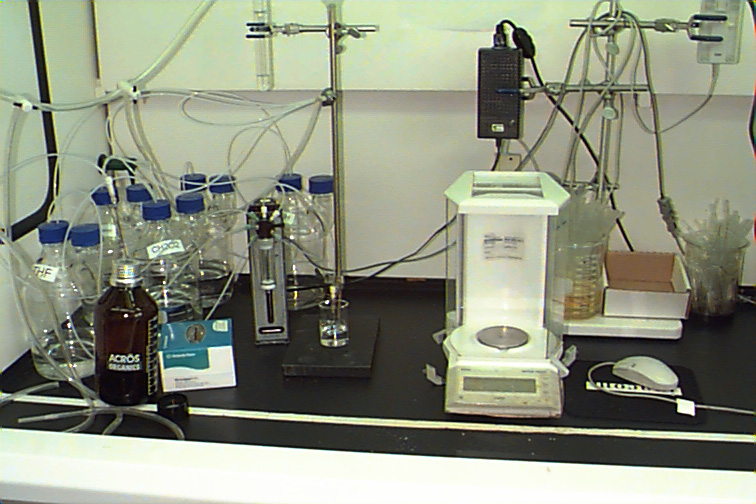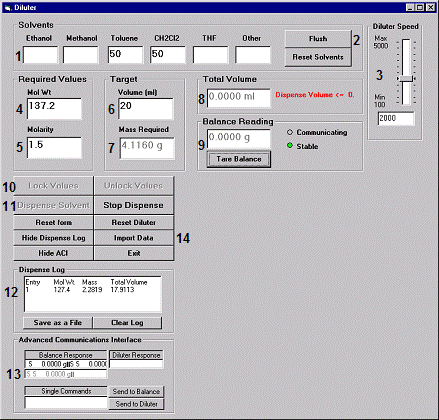The Solution Station
Introduction Over the last ten years we have been developing and using parallel synthesis for the support of lead generation and lead optimization efforts. In parallel synthesis, one approach to simplifying the manipulation of reagents and reactants is to handle them as solutions. The advantage of using solutions is fairly obvious. Solutions are more easily manipulated by pipettes and liquid handling robots and reaction stoichiometry can be directly related to delivery volume without regard to molecular weight. In contrast, the delivery of solids, which have a large variety of physical properties, is difficult to integrate into automation systems. However, preparing solutions can often be the most arduous part of setting up parallel reactions. To ease this task, we developed the "Solution Station." The system consists of a balance for weighing reagents, a syringe pump for delivering solvents and a computer to input necessary data and control the devices.
Caveats To develop a system for rapid preparation of standard solutions we faced a dilemma. Accurate preparation of a solution of known concentration (i.e. the defination of molar) requires that a sample be diluted to a specific volume. However, it was desirable to prepare solutions directly in the vials that would be used for storage and later delivery. To achieve this, we decided on a minor compromise. We assume that all reagents have a density of 1.0 and that volumes of reagents and solvents are additive. For example, to make 10 mL of a 1M ethanol solution of benzoic acid, one should dissolve 1.22 g of benzoic acid in enough ethanol to make 10 mL. Instead, we would simply add 8.78 mL of ethanol. The error in concentration for most organic reagents at 1 M is less than 1% and even for substances with anomalous densities, like triethylamine (d = 0.727), the error is less than 3%. We could include an option for density compensation, though we haven't done this yet. It is not possible to compensate for compresssbility on mixing. (Note: newer versions of the software allow one to enter densities, when known)

Picture 1. The Solution Station with solvent reservoirs, syringe drive and balance. The control computer is off the picture to the right.
The Hardware A well used Solution Station is shown in Picture 1. It consists of a Kloehn syringe drive module equipped with a 25 mL syringe and an 8-way valve, a Mettler Toledo analytical balance and a computer running Microsoft Windows 2000. The syringe drive and the balance are both controlled via an RS-232 interface using a graphical user interface developed in Microsoft Visual Basic 6.0. There are five solvents connected to the syringe drive along with an extra line for "Other."

Picture 2. The Graphical interface to the Solution Station.
Software and Operation A picture of the graphical interface is shown in Picture 2. with various windows and buttons labeled for this discussion. To prepare solutions, the chemist comes to the Solution Station with compounds to be dissolved and empty vials (usually 20 or 40 mL EPA vials) for the solutions. The desired solvent composition is entered into the solvent windows 1. Most chemists bring their own solvent and type 100 in the "Other" window, though any combination, as long as the total is 100, is possible. The syringe pump is then flushed to remove air by touching the Flush button 2. The syringe speed can be slowed for viscous solvents or solvents that cavitate easily (eg. methylene chloride) by adjusting Slider 3. The chemist then enters the molecular weight (window 4), the desired concentration (window 5) and the target volume of the final solution (window 6) Using this information, the computer calculates the amount of compound needed to reach the target volume and displays it in window 7.
The chemist places an empty vial on the balance and tares the balance by either pressing the tare button on the balance itself or by clicking button 9 on the computer screen. The weight registered on the balance is shown in window 9. Compound is then added to the vial using the target mass displayed in window 7 as a guide. The balance reading (mass of the compound added) appears in window 9 and the computer calculates and displays (in real time) the total volume of the resulting solution in window 8. There is no requirement for accuracy in the weighing except that too much compound may result in the vial overflowing and too little might not be enough for planned experiments. When the chemist is satisfied that the total volume is adequate and the balance has stabilized (stable light next to window 9 turns green), he touches the lock values button 10, moves the vial to the solvent spout by the syringe pump and touches the dispense solvent button 11. The appropriate amount of solvent is dispensed and the molecular weight window 4 is blanked to force the conscious entry of a new molecular weight for the next solution. The solvent, molarity and target volume values are retained for the next solution. If a large volume of solution (>25 mL syringe volume) is required, the syringe pump will make multiple deliveries to reach the required amount. Generally, solutions take less than a minute each to prepare, with most of the time consumed by opening and closing the reagent bottle and removing sample to place in the vial.
There are a few other features that are occasionally useful. Window 12 shows a data log of the solutions as they are made. Window 13 shows and allows for low level communication with the devices (syringe and balance). This was useful for development purposes but is now usually closed. There is the capability to read molecular weights from a text file using button 14, however, in practice most chemists prefer to just type in the molecular weights from a vial label or from the reagent bottle label.
There are commercial instruments available that operate similarly to the process described above. Most utilize liquid handling robots that add additional features such as moving the sample from the balance to the spout and capping, labeling and agitating the final solution. However, the chemist is still required to manually weigh out the sample, which remains the most tedious and time consuming part of the process. We felt that the robot increased cost, complexity and lab space requirements while only handling trivial parts of the process. Because we needed the capabilities for solution preparation at numerous sites, we sought a low cost, user-friendly and efficient system. The Solution Station has adequately satisfied each of these goals and has enhanced our parallel synthesis capabilities for lead generation and lead optimization.
Summary Handling reactants and reagents as standard concentration solutions is an important practice in accelerating parallel synthesis. Preparing solutions can be one of the more tedious aspects of parallel synthesis. We have described and implemented an inexpensive system for preparing stock solutions. The system, called the Solution Station, removes much of the tedium without imposing the excessive cost, space and training requirements of complex automation. By making solution preparation much less tedious, the Solutio Station has lowered the barrier for our chemists extending their chemistry from one at a time to parallel formats.

